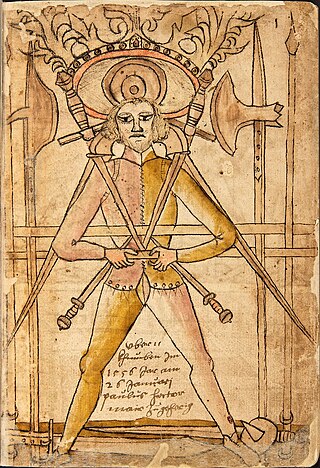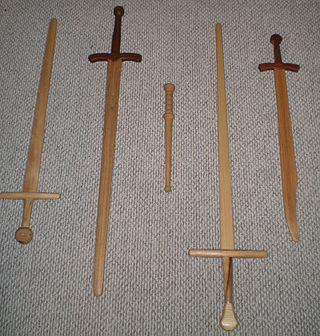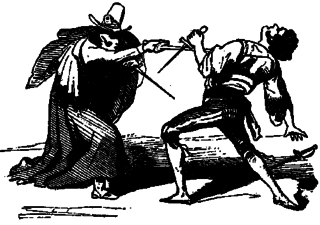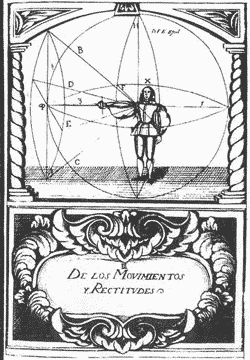
Dual wielding is the technique of using two weapons, one in each hand for training or combat. It is not a common combat practice. Although historical records of dual wielding in war are limited, there are numerous weapon-based martial arts that involve the use of a pair of weapons. The use of a companion weapon is sometimes employed in European martial arts and fencing, such as a parrying dagger. Miyamoto Musashi, a Japanese swordsman and ronin, was said to have conceived of the idea of a particular style of swordsmanship involving the use of two swords.
A sword is an edged, bladed weapon intended for manual cutting or thrusting. Its blade, longer than a knife or dagger, is attached to a hilt and can be straight or curved. A thrusting sword tends to have a straighter blade with a pointed tip. A slashing sword is more likely to be curved and to have a sharpened cutting edge on one or both sides of the blade. Many swords are designed for both thrusting and slashing. The precise definition of a sword varies by historical epoch and geographic region.

A rapier or espada ropera is a type of sword used in Renaissance Spain to designate a sword with a straight, slender and sharply pointed two-edged long blade wielded in one hand. It was widely popular in Western Europe throughout the 16th and 17th centuries as a symbol of nobility or gentleman status.
The French estoc is a type of sword, also called a tuck in English, in use from the 14th to the 17th century. It is characterized by a cruciform hilt with a grip for two-handed use and a straight, edgeless, but sharply pointed blade around 36 to 52 in in length. It is noted for its ability to pierce mail armor.
A flame-bladed sword or wave-bladed sword has a characteristically undulating style of blade. The wave in the blade is often considered to contribute a flame-like quality to the appearance of a sword. The dents on the blade can appear parallel or in a zig-zag manner. The two most common flame-bladed swords are rapiers or Zweihänders. A flame-bladed sword was not exclusive to a certain country or region. The style of blade can be found on swords from modern-day Germany, France, Spain, and Switzerland.

Swordsmanship or sword fighting refers to the skills and techniques used in combat and training with any type of sword. The term is modern, and as such was mainly used to refer to smallsword fencing, but by extension it can also be applied to any martial art involving the use of a sword. The formation of the English word "swordsman" is parallel to the Latin word gladiator, a term for the professional fighters who fought against each other and a variety of other foes for the entertainment of spectators in the Roman Empire. The word gladiator itself comes from the Latin word gladius, which is a type of sword.

Historical European martial arts (HEMA) are martial arts of European origin, particularly using arts formerly practised, but having since died out or evolved into very different forms.

The English language terminology used in the classification of swords is imprecise and has varied widely over time. There is no historical dictionary for the universal names, classification, or terminology of swords; a sword was simply a single-edged or double-edged knife.

In martial arts, a waster is a practice weapon, usually a sword, and usually made out of wood, though nylon (plastic) wasters are also available. Nylon is safer than wood, due to it having an adequate amount of flex for thrusts to be generally safe, unlike wooden wasters. Even a steel feder has more flex than most wooden wasters. The use of wood or nylon instead of metal provides an economic option for initial weapons training and sparring, at some loss of genuine experience. A weighted waster may be used for a sort of strength training, theoretically making the movements of using an actual sword comparatively easier and quicker, though modern sports science shows that an athlete would most optimally train with an implement which is closest to the same weight, balance, and shape of the tool they will be using. Wasters as wooden practice weapons have been found in a variety of cultures over a number of centuries, including ancient China, Ireland, Iran, Scotland, Rome, Egypt, medieval and renaissance Europe, Japan, and into the modern era in Europe and the United States. Over the course of time, wasters took a variety of forms not necessarily influenced by chronological succession, ranging from simple sticks to clip-point dowels with leather basket hilts to careful replicas of real swords.

The term Italian school of swordsmanship is used to describe the Italian style of fencing and edged-weapon combat from the time of the first extant Italian swordsmanship treatise (1409) to the days of classical fencing.

Francesco Ferdinando Alfieri was a master of fencing of the 17th century. He was a representative of the Venetian school of fencing and “Maestro D’Arme” to the Accademia Delia in Padua in 1640. Alfieri was originally from Padua, which at that time was territory of the Venetian Republic.
Association for Renaissance Martial Arts (ARMA) is a US-based non-profit organization dedicated to the study and practice of historical European martial arts of the 15th to 17th centuries.
Rapier Combat is a style of historical fencing practiced in the Society for Creative Anachronism (SCA). The primary focus is to study, replicate and compete with styles of rapier sword-fighting found in Europe during the Renaissance period, using blunted steel swords and a variety of off-hand defensive items. Participants wear period clothing while competing, along with or incorporating protective equipment for safety. In the April 2020 update of the rules, the sport was renamed 'Fencing Combat'.

The Zweihänder, also Doppelhänder ("double-hander"), Beidhänder ("both-hander"), Bihänder, or Bidenhänder, is a large two-handed sword that was used primarily during the 16th century.

Salvator Fabris (1544-1618) was an Italian fencing master from Padua. During his life he taught in various European countries, most notably in Denmark where he was the fencing instructor of King Christian IV. It was during his time in Copenhagen that he published his treatise on rapier fencing, Lo Schermo, overo Scienza d’Arme, in 1606. The treatise became a fencing bestseller around Europe, and was reprinted until 1713 and translated into several languages, notably into German, and again in 2005, into English.

The parrying dagger is a category of small handheld weapons from the European late Middle Ages and early Renaissance. These weapons were used as off-hand weapons in conjunction with a single-handed sword such as a rapier. As the name implies they were designed to parry, or defend, more effectively than a simple dagger form, typically incorporating a wider guard, and often some other defensive features to better protect the hand as well. They may also be used for attack if an opportunity arises. The general category includes two more specific types, the sword breaker and trident dagger.

"Cloak and dagger" was a fighting style common in the Renaissance involving a knife hidden beneath a cloak. The term later came into use as a metaphor, referring to situations involving intrigue, secrecy, espionage, or mystery.

La Verdadera Destreza is the conventional term for the Spanish tradition of fencing of the early modern period. The word destreza literally translates to 'dexterity' or 'skill, ability', and thus la verdadera destreza to 'the true skill' or 'the true art'.

The Renaissance Sword Club is a historical European martial arts group based in London, South East of England and Brittany, France. It was founded in 2013 by Rob Runacres. Its primary aim is the research and recreation of European swordsmanship of the sixteenth and seventeenth centuries, specifically those concerned with the rapier and spada da lato, as well as their companion weapons such as the dagger, cloak, buckler and rotella. Members have also pursued interests outside of the core curriculum in to staff weapons, longsword and small sword.














